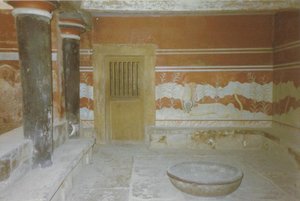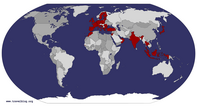Advertisement
Published: July 14th 2016

 Throne Room
Throne Room
Knossos, HeraklionHello my fellow travelers!
This is first and only post I'll do about a trip to Greece from August 22 to September 4, 1997 that I did together with my parents, my uncle Anders and my grandmother Evy. During our stay on Crete we lived in a beautiful apartment in the picturesque little village of Platanias. It's a quiet little hamlet with only a few thousand inhabitants but despite it's small stature though there is no shortage of pleasurable ways to spend your time here. There's a plethora of wonderful restaurants with really good Greek cuisine. For our first few days we took it easy, spending much on the beach near our apartment.
One evening our hotel arranged a very nice show with both local dancers, performing traditional dances, as well as our own travel guides performing some funny and lighthearted dancing and singing. While watching the show we were served several delicious dishes and drinks and after the performance some of the local dancers came down to say hello and were kind enough to pose for a couple of photos. They were very talented and it was a wonderful evening with much laughter and joy.
We also
did quite a bit of shopping, ate a lot of good food and just generally enjoyed life. I remember buying an adult-themed deck of cards and pen. There were also several t-shirts with various levels of similar crude humour available. I also bought a few things more on the clean and traditional side such as a pair of small urns with Greek motifs. I still have them in my home today, a reminder of my travels of youth. The deck of cards and pen have both been lost to time (not to mention wear and tear).
After a few days of catering to my parents with the beaches, bathing, relaxing and shopping it was finally time for something that would truly catch my attention. We decided to visit Knossos and the Minoan Palace there. It was a breathtaking experience for me as I have always, from a very young age, harboured a great interest in history. Knossos is often considered to be the oldest city in Europe and the city is shrouded not only in history but also in mythology.
It is the home to the fabled legend of the Minotaur and the Labyrinth. The Minotaur, or Asterion,
as it's true name was, was the son of the Cretan Bull and Pasiphae, daughter of the sun god Helios and the wife of King Minos. King Minos angered the god Poseidon when he refused to sacrifice the Cretan Bull and as punishment Poseidon caused Pasiphae to fall in love with the bull and mate with it, giving birth to Asterion.
Because he was half human and half beast Asterion was forced to devour humans instead of regular food. As he grew older and more ferocious King Minos had a massive Labyrinth constructed beneath the palace to contain him.
King Minos then demanded that Athens would send their seven bravest youths and their seven most beautiful maidens as a sacrifice for Asterion every seven years. This was a punishment from when the Athenians slew the son of King Minos during the Panathenaic Games. When the third sacrifice was at hand Theseus volunteered to slay the Minotaur. He was aided by Ariadne, the daughter of King Minos, whom had fallen in love with him.
She gave him a string which would guide him back out from the labyrinth and with it he went down into the dark where
he encountered Asterion. A fierce fight ensued but Theseus was strong and managed to overwhelm Asterion and cut his throat.
After Theseus slew Asterion he decapitated the body and then followed the string out of the labyrinth together with the other youths and maidens. He then left Knossos together with Ariadne and her sister Phaedre.
Excavations of Knossos began in 1900 under the supervision of the English archaeologist Arthur Evans and they continued for 35 years. These excavations show that during the height of it's power, in 1700 BC, the area around Knossos was inhabited by 100,000 people which far exceeded the initial expectations.
For me this was the high point of this trip as it brought to life the myths of old, the story of Theseus and the Minotaur, and I will never forget it.
After the exploration of the Minoan palace at Knossos we all got a taste for further exploration so we went to Chánia to explore the area around the old harbour. It is a beautiful area of the city with the lighthouse in the background and a plethora of interesting sights such as the Küçük Hasan Mosque which was built by
the Turks in 1645 after their conquest of Crete. There are several old buildings remaining from when the Venetians ruled the city. The Nautical Museum of Crete is housed inside the Firkas Fortress which was built by them in 1620.
After a few days of exploration we decided to spend a few quiet days at the beach again, only interrupted by some ventures to find new and exciting places to partake in culinary delights. We ate a lot of great food during our time in Crete. One evening we ate at a lovely restaurant located far on top of the hillside overlooking Platanias and it was such a beautiful place. It was a wonderful place with delicious food and a great view.
For our last day in Greece we decided to take a proper tour of western Crete. The first stop of the tour was Lake Kournas, Crete's only fresh water lake. It's a beautiful area where you can receive a feet treatment from the many small fish that inhabit the shallow waters near the beach.
Close to the lake is the Lefka Ori, a mountain range that reflects magnificently on the mirror-like waters. Lake Kournas used
to be named Lake Korisia after the city Korion which is thought to have been located here, centred around a temple dedicated to Athena.
Our second stop was the Kourtaliotiko Gorge, which is a quite large gorge running around the Kourtaliotiko River. The gorge and the river get their name from the natural phenomenon that can be heard at a specific point in the gorge. The sound stems from the wind being funneled through the high caves of the gorge which creates a sound similar to that of hands clapping.
Aside from the natural phenomenon of the clapping noise the gorge is also known as a roosting site of the bearded vulture but unfortunately we didn't see any of them today. There is also a small and quite beautiful church in the gorge called the Church of St. Nicholas.
Next we went to Preveli to visit the Preveli Monastery which was founded in the Middle Ages. Ever since then it has been a bastion of resistance against the occupations of Crete. One of it's abbots took part in the Daskalogiannis Revolt fought between 1770 and 1771. The leader of the revolt, Daskalogiannis, was caught and tortured to
death by the Turks who made his brother watch. Watching the torture drove his brother mad but Daskalogiannis himself endured it in silence.
During the Greek War of Independence between 1821 and 1830 the abbot of the monastery led the resistance against the Turks from here, resulting in the destruction of the monastery. It was rebuilt and once again used as a base in new rebellions against the Turks In 1866 and 1878.
During the battle for Crete in 1941 the monastery was used to supply the allies and provide shelter for their soldiers until they could be rescued, as a result the Germans destroyed the lower parts of the monastery so only the upper parts remains.
From the Monastery of Preveli we headed to Frangokastello to see the impressive Frangokastello Fortress. It's a massive fort built by the Venetians between 1371 and 1374 in an attempt to impose order on the rebellious Sfakiots. The Venetians originally named it the Castle of St. Nikitas after a nearby church but the locals never took a liking to the name and instead they called it Frangokastello.
The name became so commonly used that even the Venetians eventually adopted
it and now it's the name of not only the fortress but the small settlement surrounding it as well. When the Venetians was constructing the fortress it was demolished every night by the locals under the command of six Patsos brothers. This forced the Venetians to bring in more troops to the region and eventually the Patsos brothers was betrayed, captured and hanged.
As with the Preveli Monastery this castle was used in the aforementioned revolts against the Turks and this is where Daskalogiannis was captured. In 1828 Hatzimichalis Dalianis tried to spread the Greek War of Independence to Crete and he captured the fortress from the Turkish forces. The Turks reorganised though and assaulted the fort with over 8,000 men against a few hundred Sfakiot and Epirot defenders. They fought bravely but the fortress was recaptured by the Turks and Hatzimichalis Dalianis died in the battle along with most of his men.
It's said that every year around the time of the battle the shadows of the fallen soldiers can be seen marching towards the fortress. They are known as the
Drosoulites, the Dew Men. This is actually a real thing but it has been explained as
a meteorological phenomenon rather than a paranormal one. I can imagine it being quite eerie to witness it though, knowing about the history and local folklore. I want to return here to see it myself someday.
The main walls and towers are all the original constructions and the coat of arms of Venice can still be seen above the main gate. However, the buildings inside the fortress are from the Turkish period.
Our last stop of the day was the Lefka Ori, a mountain range with 58 peaks that stands over 2,000 metres high that offers a beautiful view down over the Askifou Plateau. After our mountain adventure we returned to Platanias where it was time to get ready to leave Crete the next day.
Until next time I wish you all peace and happy travels!
Advertisement
Tot: 0.298s; Tpl: 0.018s; cc: 38; qc: 154; dbt: 0.1827s; 1; m:domysql w:travelblog (10.17.0.13); sld: 1;
; mem: 1.7mb

























